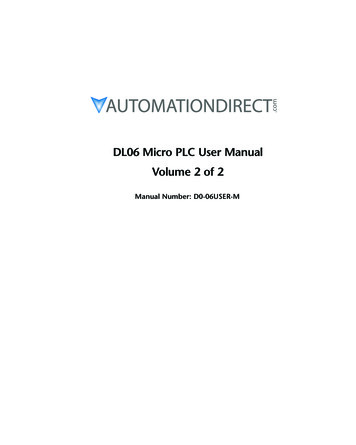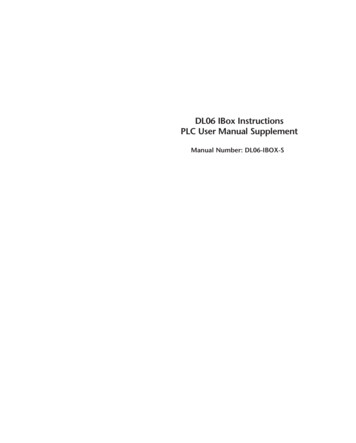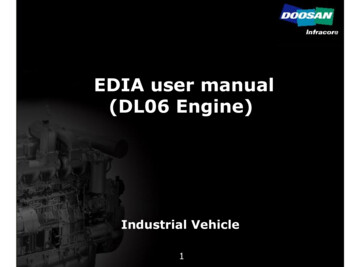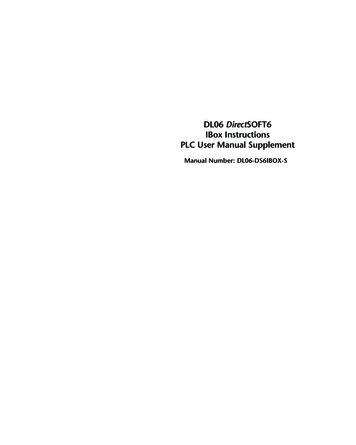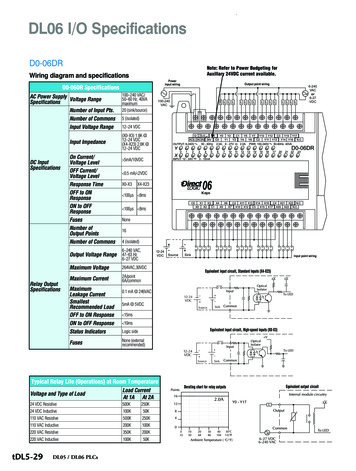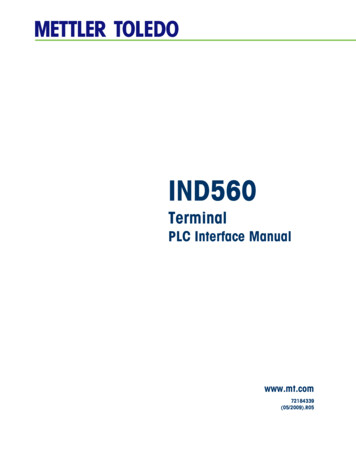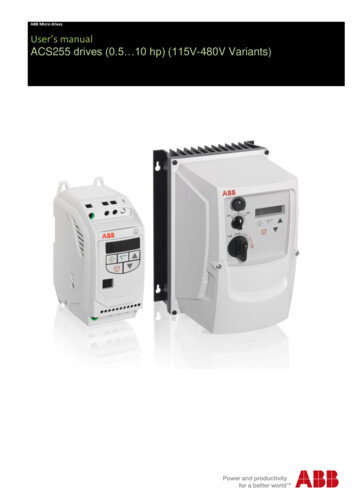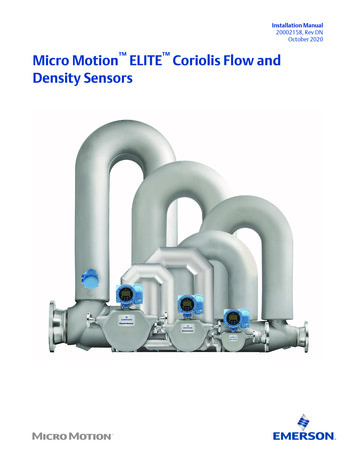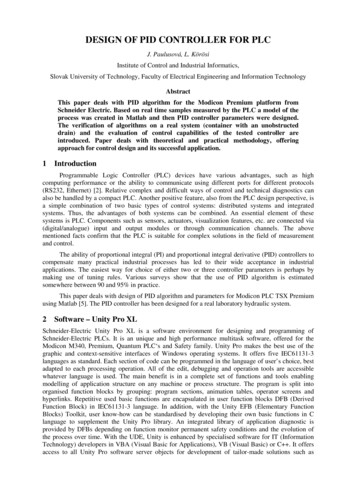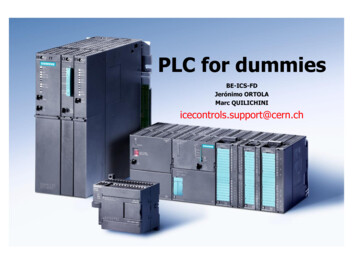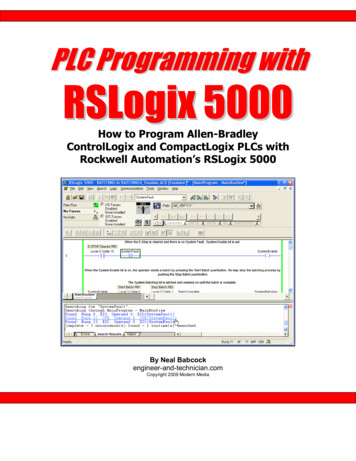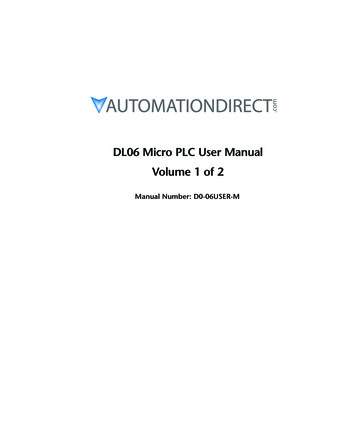
Transcription
DL06 Micro PLC User ManualVolume 1 of 2Manual Number: D0-06USER-M
DL06 Micro PLC User Manual, 3rd Edition, Rev. D
WARNING Thank you for purchasing automation equipment from Automationdirect.com , doing business as,AutomationDirect. We want your new automation equipment to operate safely. Anyone who installs oruses this equipment should read this publication (and any other relevant publications) before installing oroperating the equipment.To minimize the risk of potential safety problems, you should follow all applicable local and nationalcodes that regulate the installation and operation of your equipment. These codes vary from area to areaand usually change with time. It is your responsibility to determine which codes should be followed, andto verify that the equipment, installation, and operation is in compliance with the latest revision of thesecodes.At a minimum, you should follow all applicable sections of the National Fire Code, National ElectricalCode, and the codes of the National Electrical Manufacturer’s Association (NEMA). There may be localregulatory or government offices that can also help determine which codes and standards are necessary forsafe installation and operation.Equipment damage or serious injury to personnel can result from the failure to follow all applicablecodes and standards. We do not guarantee the products described in this publication are suitable foryour particular application, nor do we assume any responsibility for your product design, installation, oroperation.Our products are not fault-tolerant and are not designed, manufactured or intended for use or resale ason-line control equipment in hazardous environments requiring fail-safe performance, such as in theoperation of nuclear facilities, aircraft navigation or communication systems, air traffic control, direct lifesupport machines, or weapons systems, in which the failure of the product could lead directly to death,personal injury, or severe physical or environmental damage (“High Risk Activities”). AutomationDirectspecifically disclaims any expressed or implied warranty of fitness for High Risk Activities.For additional warranty and safety information, see the Terms and Conditions section of our catalog.If you have any questions concerning the installation or operation of this equipment, or if you needadditional information, please call us at 770-844-4200.This publication is based on information that was available at the time it was printed. AtAutomationDirect we constantly strive to improve our products and services, so we reserve the right tomake changes to the products and/or publications at any time without notice and without any obligation.This publication may also discuss features that may not be available in certain revisions of the product.TrademarksThis publication may contain references to products produced and/or offered by other companies. Theproduct and company names may be trademarked and are the sole property of their respective owners.AutomationDirect disclaims any proprietary interest in the marks and names of others.Copyright 2016, Automationdirect.com IncorporatedAll Rights ReservedNo part of this manual shall be copied, reproduced, or transmitted in any way without the prior, writtenconsent of Automationdirect.com Incorporated. AutomationDirect retains the exclusive rights to allinformation included in this document.
AVERTISSEMENT Nous vous remercions d’avoir acheté l’équipement d’automatisation de Automationdirect.comMC, en faisant desaffaires comme, AutomationDirect. Nous tenons à ce que votre nouvel équipement d’automatisation fonctionne entoute sécurité. Toute personne qui installe ou utilise cet équipement doit lire la présente publication (et toutes lesautres publications pertinentes) avant de l’installer ou de l’utiliser.Afin de réduire au minimum le risque d’éventuels problèmes de sécurité, vous devez respecter tous les codes locauxet nationaux applicables régissant l’installation et le fonctionnement de votre équipement. Ces codes diffèrent d’unerégion à l’autre et, habituellement, évoluent au fil du temps. Il vous incombe de déterminer les codes à respecter etde vous assurer que l’équipement, l’installation et le fonctionnement sont conformes aux exigences de la version laplus récente de ces codes.Vous devez, à tout le moins, respecter toutes les sections applicables du Code national de prévention des incendies,du Code national de l’électricité et des codes de la National Electrical Manufacturer’s Association (NEMA). Desorganismes de réglementation ou des services gouvernementaux locaux peuvent également vous aider à déterminerles codes ainsi que les normes à respecter pour assurer une installation et un fonctionnement sûrs.L’omission de respecter la totalité des codes et des normes applicables peut entraîner des dommages à l’équipementou causer de graves blessures au personnel. Nous ne garantissons pas que les produits décrits dans cette publicationconviennent à votre application particulière et nous n’assumons aucune responsabilité à l’égard de la conception, del’installation ou du fonctionnement de votre produit.Nos produits ne sont pas insensibles aux défaillances et ne sont ni conçus ni fabriqués pour l’utilisation ou la reventeen tant qu’équipement de commande en ligne dans des environnements dangereux nécessitant une sécurité absolue,par exemple, l’exploitation d’installations nucléaires, les systèmes de navigation aérienne ou de communication, lecontrôle de la circulation aérienne, les équipements de survie ou les systèmes d’armes, pour lesquels la défaillance duproduit peut provoquer la mort, des blessures corporelles ou de graves dommages matériels ou environnementaux(«activités à risque élevé»). La société AutomationDirect nie toute garantie expresse ou implicite d’aptitude àl’emploi en ce qui a trait aux activités à risque élevé.Pour des renseignements additionnels touchant la garantie et la sécurité, veuillez consulter la section Modalités etconditions de notre documentation. Si vous avez des questions au sujet de l’installation ou du fonctionnement de cetéquipement, ou encore si vous avez besoin de renseignements supplémentaires, n’hésitez pas à nous téléphoner au770-844-4200.Cette publication s’appuie sur l’information qui était disponible au moment de l’impression. À la sociétéAutomationDirect, nous nous efforçons constamment d’améliorer nos produits et services. C’est pourquoi nousnous réservons le droit d’apporter des modifications aux produits ou aux publications en tout temps, sans préavis niquelque obligation que ce soit. La présente publication peut aussi porter sur des caractéristiques susceptibles de nepas être offertes dans certaines versions révisées du produit.Marques de commerceLa présente publication peut contenir des références à des produits fabriqués ou offerts par d’autres entreprises. Lesdésignations des produits et des entreprises peuvent être des marques de commerce et appartiennent exclusivement àleurs propriétaires respectifs. AutomationDirect nie tout intérêt dans les autres marques et désignations.Copyright 2016, Automationdirect.com IncorporatedTous droits réservésNulle partie de ce manuel ne doit être copiée, reproduite ou transmise de quelque façon que ce soit sans leconsentement préalable écrit de la société Automationdirect.com Incorporated. AutomationDirect conserve lesdroits exclusifs à l’égard de tous les renseignements contenus dans le présent document.
DL06 Micro PLC USER MANUALPlease include the Manual Number and the Manual Issue, both shown below,when communicating with Technical Support regarding this publication.Manual Number:D0-06USER-MIssue:3rd Edition, Rev. DIssue Date:6/16Publication HistoryIssueDateDescription of ChangesFirst EditionRev. ARev. B7/0210/026/032nd Edition3/04OriginalUpdated drawing images and made minor corrections.Added new PLC and made numerous corrections.Added two appendices, removed discrete module data and made numerouscorrections.3rd Edition3/07Corrected all tables, many corrections to Chapters 2, 3, 4, 5, 6, and 7; Chapter 3(HSIO) was moved to the Appendices and Chapter 4 was divided into Chapters 3 &4; added DS5 Intelligent Boxes to Chapter 5; added Ramp/Soak example to Chapter8; Numbering Systems and Serial Communications were added to Appendices; manyminor corrections were made throughout manual.Rev. A5/07Minor corrections and updates.Rev. B6/11Updated Chapter 5 with current DirectSOFT dialog views, corrected number ofregisters needed to use the print message instruction, removed fuses and correctedI/O wiring drawings, and other minor corrections and updates.Rev. C2/13Added H0-CTRIO2 references.Minor corrections and updates.Added transient suppression for inductive loads.Rev. D6/16Corrections and updates.
NotesDL06 Micro PLC User Manual
Table of ContentsChapter 1: Getting StartedIntroduction. 1–2The Purpose of this Manual. 1–2Supplemental Manuals. 1–2Technical Support. 1–2Conventions Used. 1–3Key Topics for Each Chapter. 1–3DL06 Micro PLC Overview. 1–4The DL06 PLC Features. 1–4DirectSOFT Programming for Windows . 1–4Handheld Programmer. 1–5I/O Quick Selection Guide. 1–5Quick Start. 1–6Steps to Designing a Successful System. 1–10Questions and Answers about DL06 Micro PLCs. 1–12Chapter 2: Installation, Wiring, and SpecificationsSafety Guidelines. 2–2Plan for Safety. 2–2Three Levels of Protection. 2–3Emergency Stops. 2–3Emergency Power Disconnect. 2–4Orderly System Shutdown. 2–4Class 1, Division 2 Approval. 2–4Orientation to DL06 Front Panel. 2–5Terminal Block Removal. 2–6Mounting Guidelines. 2–7
Table of ContentsUnit Dimensions. 2–7Enclosures. 2–7Panel Layout & Clearances. 2–8Using Mounting Rails. 2–9Environmental Specifications. 2–10Agency Approvals. 2–10Marine Use. 2–10Wiring Guidelines. 2–11External Power Source. 2–12Planning the Wiring Routes. 2–12Fuse Protection for Input and Output Circuits. 2–13I/O Point Numbering. 2–13System Wiring Strategies. 2–14PLC Isolation Boundaries. 2–14Connecting Operator Interface Devices. 2–15Connecting Programming Devices. 2–15Sinking / Sourcing Concepts. 2–16I/O “Common” Terminal Concepts. 2–17Connecting DC I/O to “Solid State” Field Devices. 2–18Solid State Input Sensors. 2–18Solid State Output Loads. 2–18Relay Output Wiring Methods. 2–20Relay Outputs-Transient Suppression For Inductive Loads in a Control System. 2–21Prolonging Relay Contact Life. 2–26DC Input Wiring Methods. 2–27DC Output Wiring Methods. 2–28High-Speed I/O Wiring Methods. 2–29Wiring Diagrams and Specifications. 2–30D0–06AA I/O Wiring Diagram. 2–30D0–06AR I/O Wiring Diagram. 2–32D0–06DA I/O Wiring Diagram. 2–34D0–06DD1 I/O Wiring Diagram. 2–36D0–06DD2 I/O Wiring Diagram. 2–38D0–06DR I/O Wiring Diagram. 2–40D0–06DD1–D I/O Wiring Diagram. 2–42D0–06DD2–D I/O Wiring Diagram. 2–44D0–06DR–D I/O Wiring Diagram. 2–46iiDL06 Micro PLC User Manual, 3rd Edition, Rev. D
Table of ContentsGlossary of Specification Terms. 2–48Chapter 3: CPU Specifications and OperationOverview.3–2DL06 CPU Features. 3–2CPU Specifications. 3–3CPU Hardware Setup. 3–4Communication Port Pinout Diagrams. 3–4Connecting the Programming Devices. 3–5CPU Setup Information. 3–5Status Indicators. 3–6Mode Switch Functions. 3–6Changing Modes in the DL06 PLC. 3–7Mode of Operation at Power-up. 3–7Using Battery Backup. 3–8Battery Backup. 3–8Auxiliary Functions. 3–9Clearing an Existing Program. 3–9Initializing System Memory. 3–9Setting Retentive Memory Ranges. 3–10Using a Password. 3–11CPU Operation. 3–12CPU Operating System. 3–12Program Mode. 3–13Run Mode. 3–13Read Inputs. 3–14Service Peripherals and Force I/O. 3–14CPU Bus Communication. 3–15Update Clock, Special Relays and Special Registers. 3–15Solve Application Program. 3–16Solve PID Loop Equations. 3–16Write Outputs. 3–16Write Outputs to Specialty I/O. 3–16Diagnostics. 3–17I/O Response Time. 3–17Is Timing Important for Your Application?.
DL06 Micro PLc USER MANUAL Please include the Manual Number and the Manual Issue, both shown below, when communicating with Technical Support regarding this publication. Manual Number: D0-06USER-M Issue: 3rd Edition, Rev. D Issue Date: 6/16 Publication History Issue Dat
